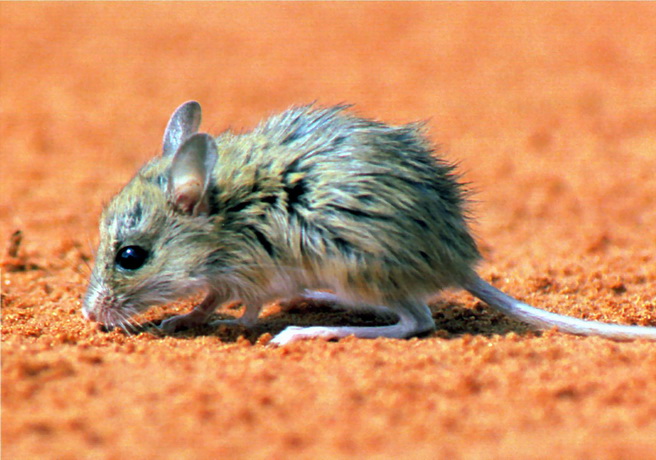|
| Query: Mulga | Result: 20th of 22 | |
Spinifex Hopping Mouse (Notomys alexis) - Wiki <!--알렉스껑충쥐-->
| Subject: | Spinifex Hopping Mouse (Notomys alexis) - Wiki
| |

| Resolution: 656x460
File Size: 112630 Bytes
Date: 2007:09:02 04:59:12
Upload Date: 2007:09:02 05:02:16
|
ERROR : Server Busy(-1105)
ERROR : Server Busy(-1105)
Spinifex Hopping Mouse (Notomys alexis) - Wiki
Spinifex Hopping Mouse
From Wikipedia, the free encyclopedia
The Spinifex Hopping Mouse (Notomys alexis), also known as the Tarkawara or Tarrkawarra, occurs throughout the central and western Australian arid zones, occupying both spinifex-covered sand flats and stabilised sand dunes, and loamy mulga and melaleuca flats.
The population fluctuates greatly: in normal years it is sparsely distributed and probably confined to sandy country; after rain the population explodes and spreads to other types of habitat for a time.
They are mostly seen at night, bounding across open ground on their large hind feet, with tails extended and the body almost horizontal.
Appearance is very similar to the Northern Hopping Mouse: a little larger than a common House Mouse at 95 to 115 mm head-body length and an average weight of 35 g. As with all hopping mice, the hind legs are greatly elongated, the fore limbs small, and the brush-tipped tail very long???about 140 mm. The fur is chestnut or fawn above, pale below, with a grey wash about the muzzle and between the eye and ear, and longer, coarse black guard hairs on the back. The tail is sparsely furred and pink, darker above than below.
Spinifex Hopping-mice live in small family groups in deep, humid burrow systems. Typically, there is a large nest chamber lined with small sticks and other plant material about a metre below the surface, from which several vertical shafts lead upwards. Shaft entrances do not have spoil heaps.
Adults emerge at dusk and spread out individually for some hundreds of metres, on all fours when moving slowly, on the hind legs alone at speed, foraging for seeds, roots, green shoots, and invertebrates. Seed is the primary diet item, other food is taken when available.
Breeding can be at any time of year depending on conditions, with spring being favoured. Pregnancy usually takes 32 days but can be extended significantly if the mother is still breastfeeding the previous brood. Litters of 3 or 4 are typical, 6 the maximum. The young remain in the nest while the female forages; if they wander both male and female adults retrieve them. They reach maturity in about 60 days.
The Spinifex Hopping Mouse is widespread and although the population fluctuates considerably, is not considered at risk.
http://en.wikipedia.org/wiki/Spinifex_Hopping_Mouse
| The text in this page is based on the copyrighted Wikipedia article shown in above URL. It is used under the GNU Free Documentation License. You may redistribute it, verbatim or modified, providing that you comply with the terms of the GFDL. |
|
Comments |
|---|
| | Guest |
|
ghuyiod5ti7dryud456sdrtyser12356789
123456789+123456789+123456789+123456789+423456789+123456789+123456789+123456789+123456789+123456789+1263456789 |
| | Guest |
|
ghuyiod5ti7dryud456sdrtyser12356789
123456789+123456789+123456789+123456789+423456789+123456789+123456789+123456789+123456789+123456789+1263456789 |
^o^
Animal Pictures Archive for smart phones
^o^
|
|
|

